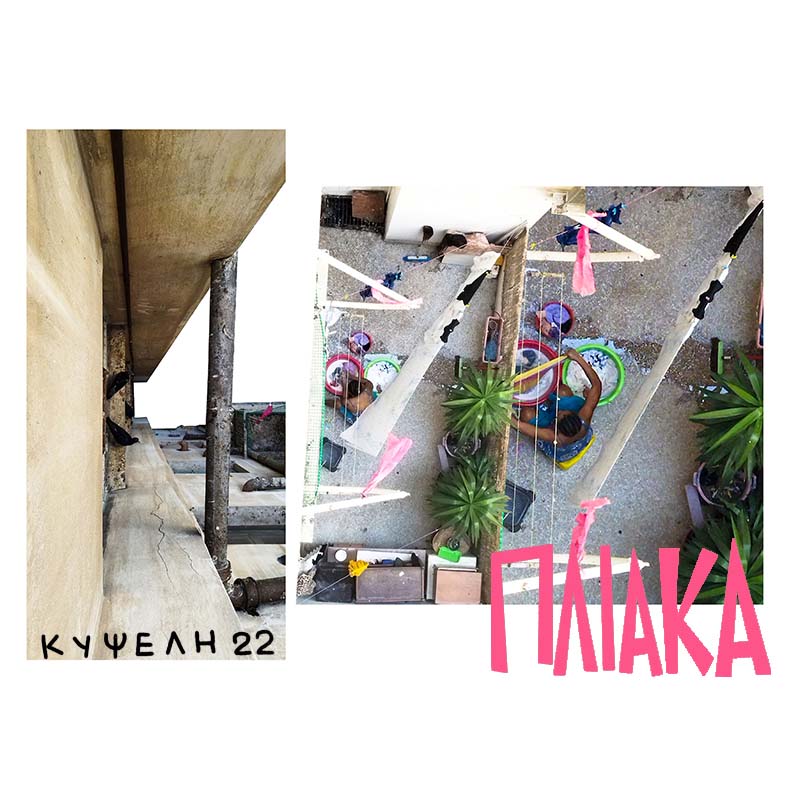

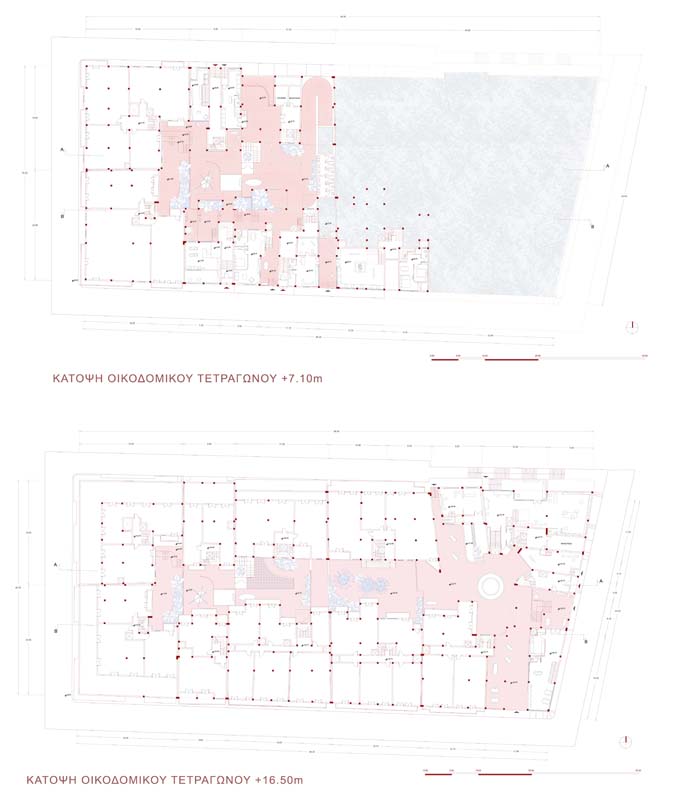

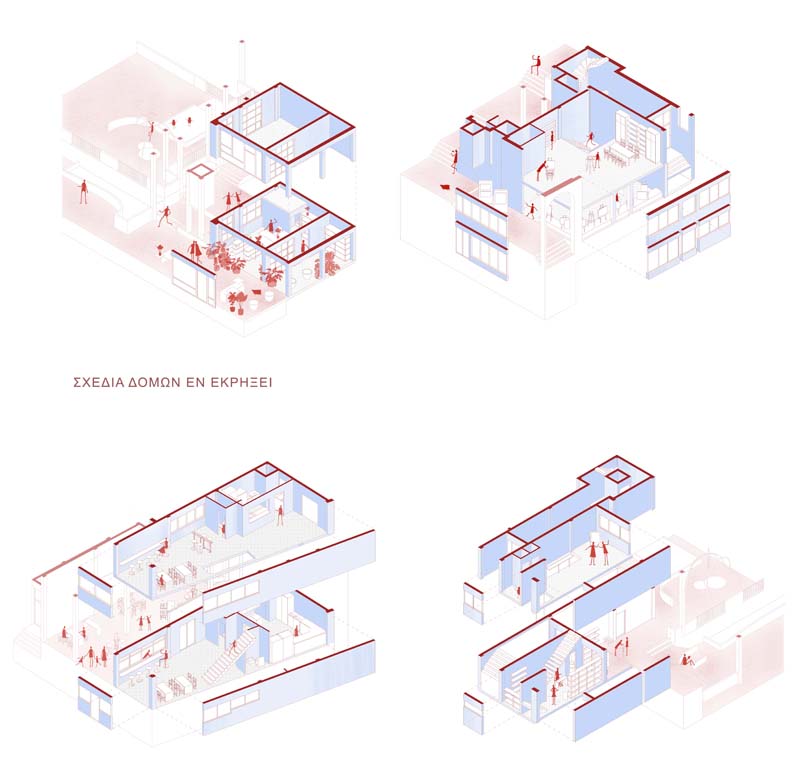

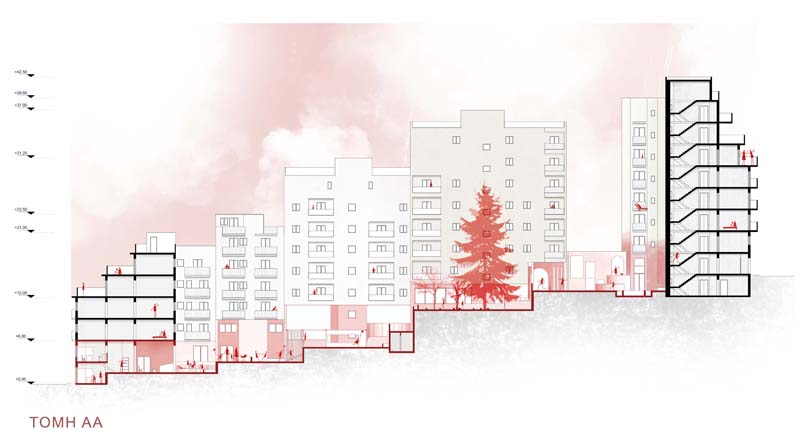

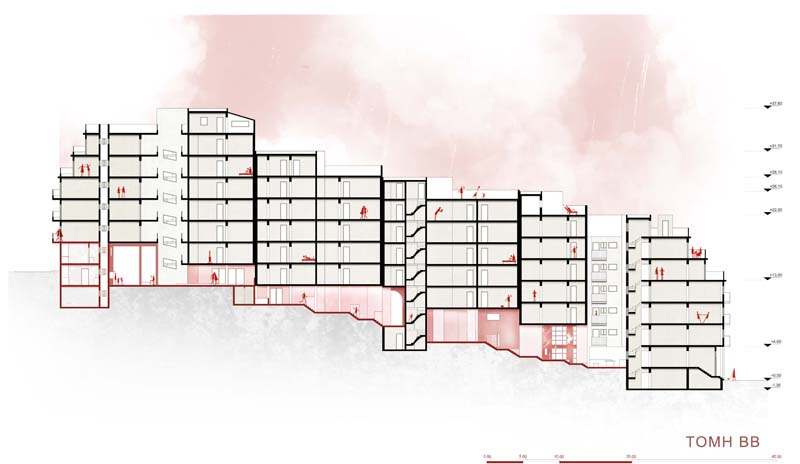

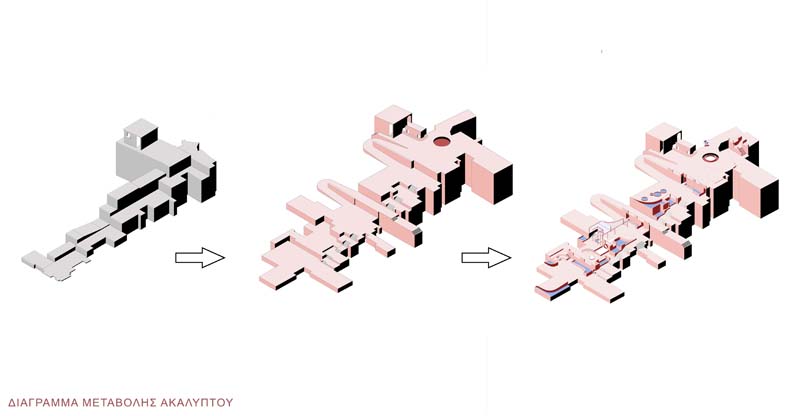

Kypseli is one of the most densely populated areas of Athens, presenting great diversity in social strata, nationalities and residential practices. The conventional neighbourhood of Kypseli is an ode to the post-war apartment building, with it dominating aesthetically neglected, overshadowing the few detached houses, fragments of an earlier era. The courtyard is articulated in the centre of each building block, acting as a channel of communication and sound dispersion between the residents of the blocks of flats, turning them into passive listeners. The older residents of the higher floors prefer the security and privacy of their apartment as opposed to the migrant residents of the ground floors and basements, who practice more extroverted habitation practices by making use of the few common spaces of the structure, sitting on the steps of the front door and leaving the doors of their apartments open.
This thesis, inspired by the absence of common spaces within the block, attempts to propose a solution for the activation of the courtyard and the formation of a micro-community of residents surrounding it, emphasizing structures of community character that come to replace ground floor and underground residences. The galleries opened at street level act as through-openings in the solid structure of the apartment building and ensure a smooth connection between the newly created communal space and the public sphere, negating the imposed boundaries of the courtyard .To sum up, the research group 'Pliaka' attempts through this work to redefine the spatial substance of the courtyard and to integrate it into the sphere of utilitarian spaces, offering the inhabitants a ground for coexistence, experimentation and freedom.
Supervisors: Gavrilou Evelyn, Psychoulis Alexandros
Reference Number: 945
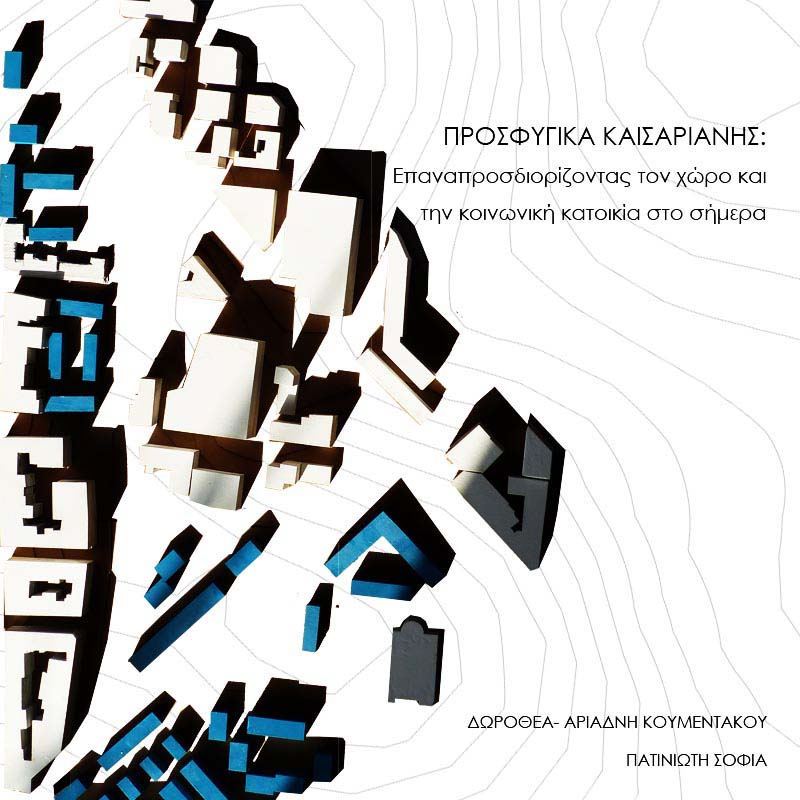

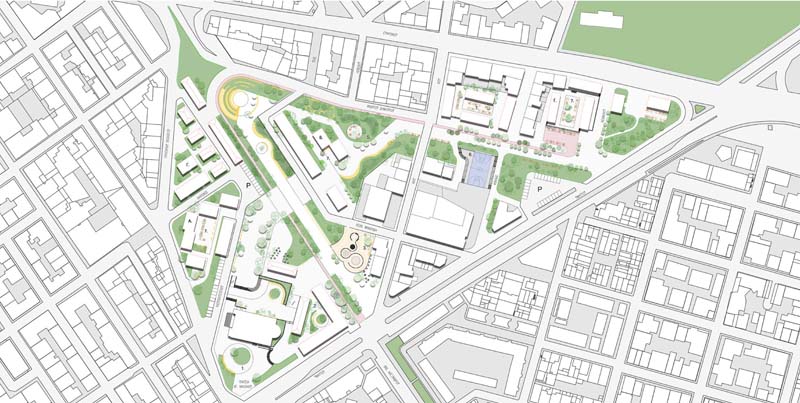

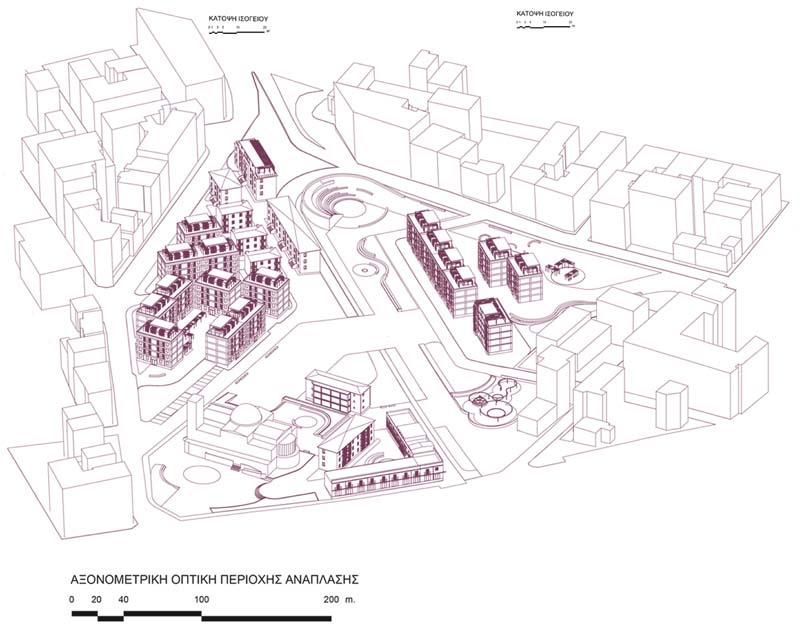

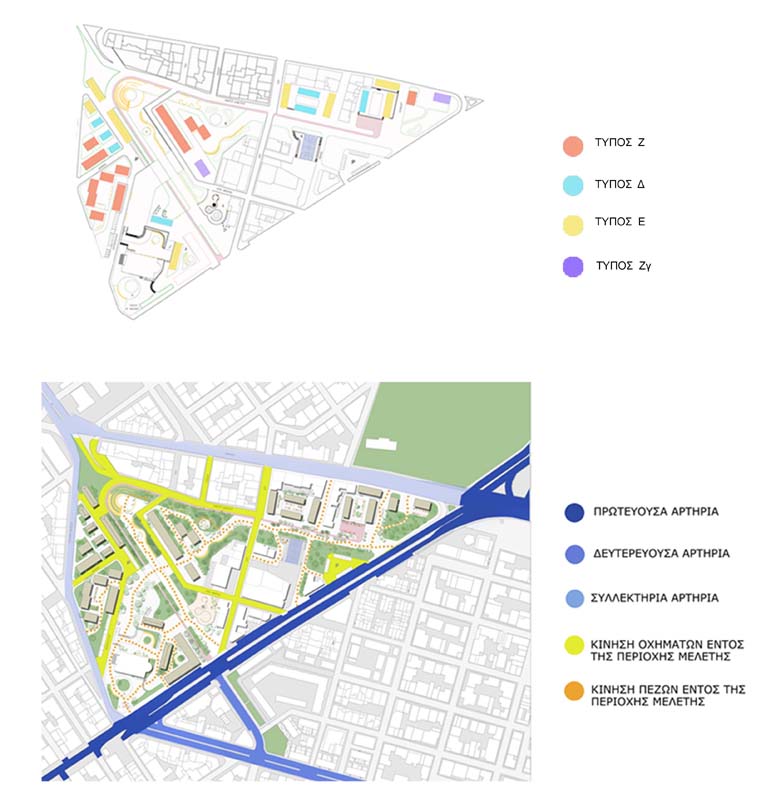

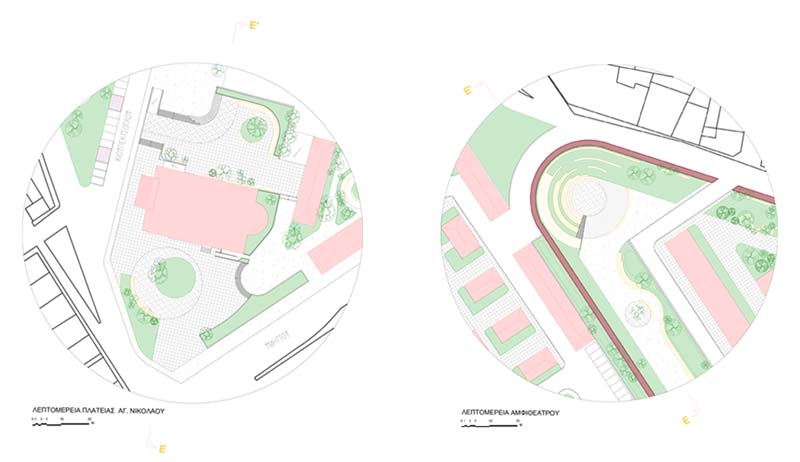

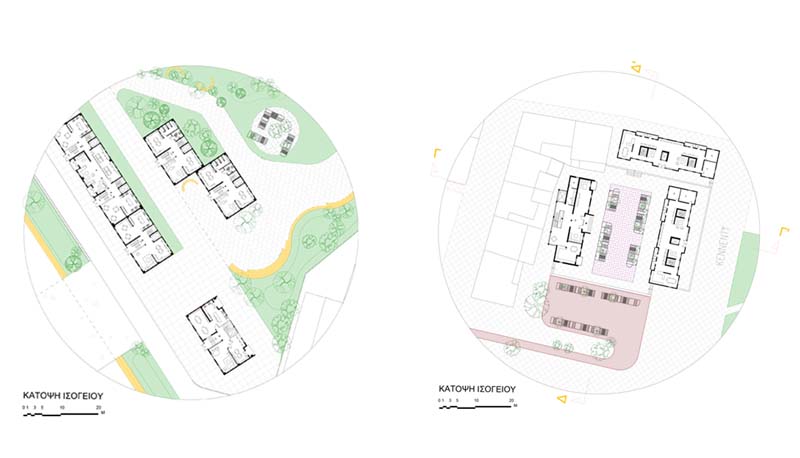

The present diploma thesis approaches the concept of co-living, in a contemporary model of social housing. It concerns the restoration and reuse of the refugee building complexes in the area of Agios Nikolaos in Kaisariani, as well as the redevelopment of the entire area that incorporates them.
Kaisariani was more developed after the period of the Asia Minor Catastrophe, when the area received a large part of the refugee stream that flowed to Greece. Gradually the refugees were transferred from more unsettled forms of housing to new apartment buildings designed with the principles of modernism, which were also a typical example of residential complexes with buildings of more coexisting households.
After insufficient development actions, the public area still needs to be re-designed and upgraded, while the refugee housing complexes seem out of place in relation to the newly built and densely populated environment that surrounds them. The new apartment buildings that are being built in the area to meet the modern housing needs have resulted in the alteration of homogeneity, and ultimately the identity of the settlement.
The proposal aims to serve a homogeneous population (related to the University), the creation of a community, and the evolution of the old structures, in order to respond to a modern model of collective housing.
Specifically, it includes the creation of new routes for the better connection of the selected complexes with the urban fabric, the remodeling of the internal common yards, the restoration and reuse of as many refugee blocks as possible. The proposed additions and configurations will serve the residents of the apartment buildings by offering more spaces for meetings, joint exploitation, while at the same time they will invite visitors to joint activities that will be developed in the area. The new operating conditions in the complexes help to redefine the relationships of people with each other, as well as with the residence and the outdoor space in the city.
Supervisor: Kanarelis Theoklis
Reference Number: 941


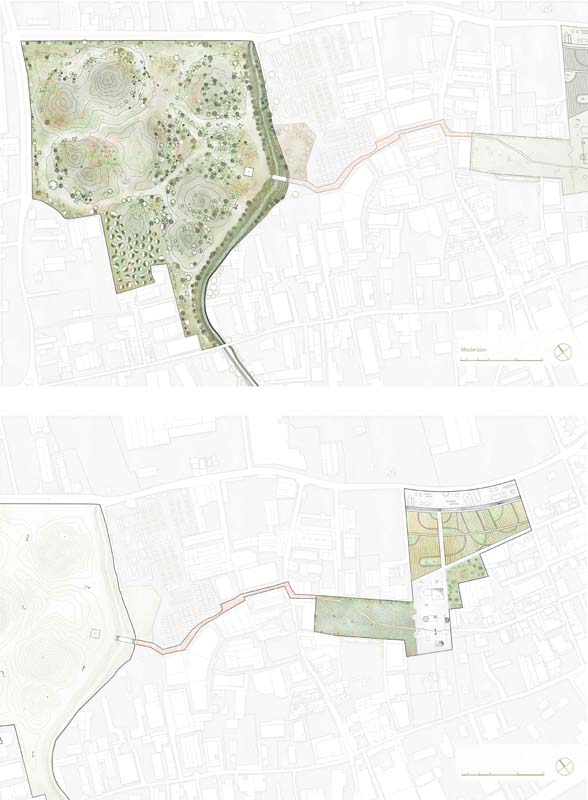



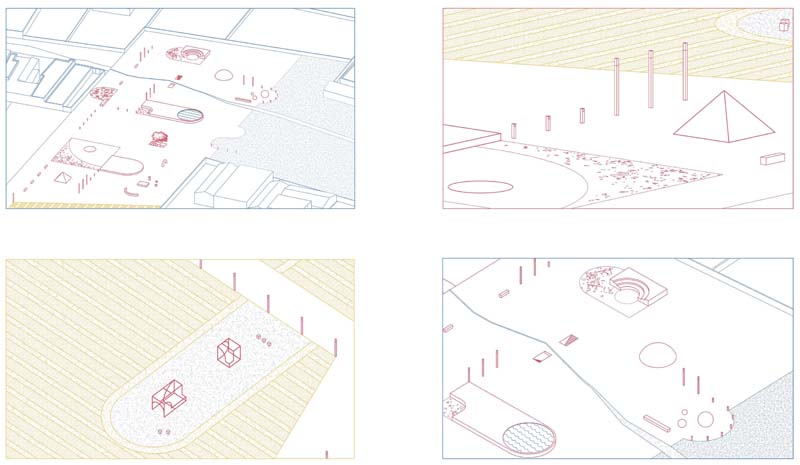

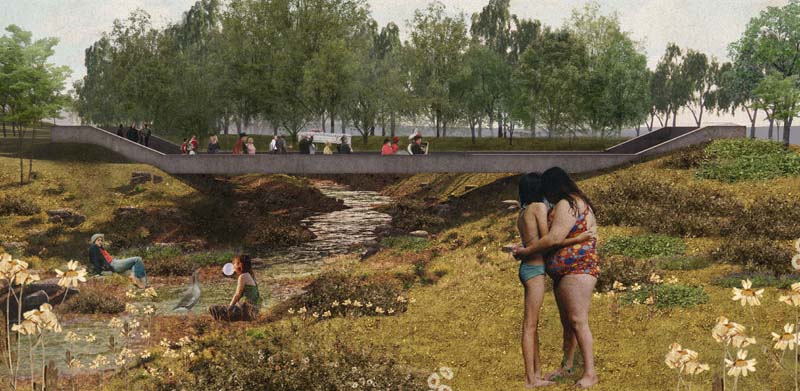

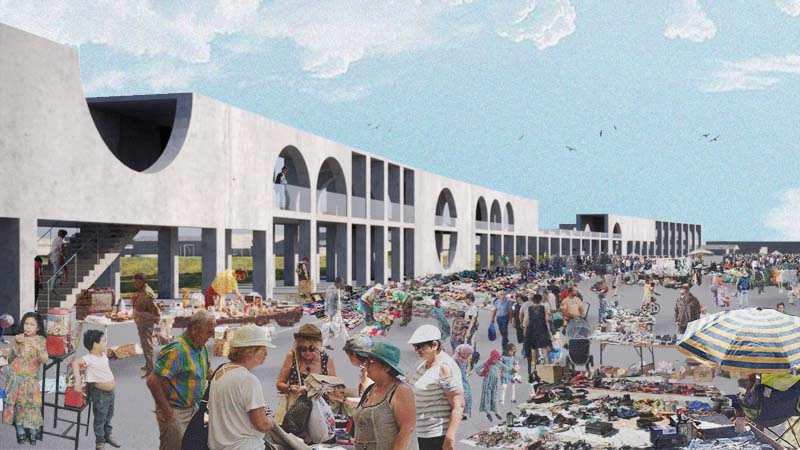

At a time when the collective character of religion, rituals, and personal faith are waning, a new "charm of death" emerges through a "secular eschatology" (Davis 2005). The growing institutionalization of ecological ethics with the emergence of recycling as a self-evident "good", transform the general mentality of the body of the dead from "miasma" to a potential "gift" for living organisms and society.
In this context and taking into account the new narratives of materiality and immanence considerating human and non-human relationships, we attempt to describe contemporary scenarios of collective practices "over the dead body" as well as the spaces that will receive them. We intervene with the logic of intrusion, in the area of Eleonas in Athens, an area of the invisible next to the city center that gathers all its unwanted uses.
Our scenario unfolds in 2 plots on Agiou Polykarpou Street which are being connected through an internal route. We enter the first plot through an arcade that serves as a threshold. Moving gradually from outside to inside, we encounter the flea market, the urban gardening area and the square of playfulness
The course ends in a meadow between the warehouses and the abandoned areas. At end of the meadow starts the internal route ("gorge") that leads to the second plot. The basic program of the second plot is on the one hand the burial of the dead (through the method of natural burial) and on the other hand the meal in honor of the dead. Outdoor kitchens are being enhanced by lightweight and furnitures.
The area is equally addressed to the relatives of the deceased, the residents of the area and visitors coming from distant parts of the city.
Supervisor: Paniyiris Costis
Reference Number: 938
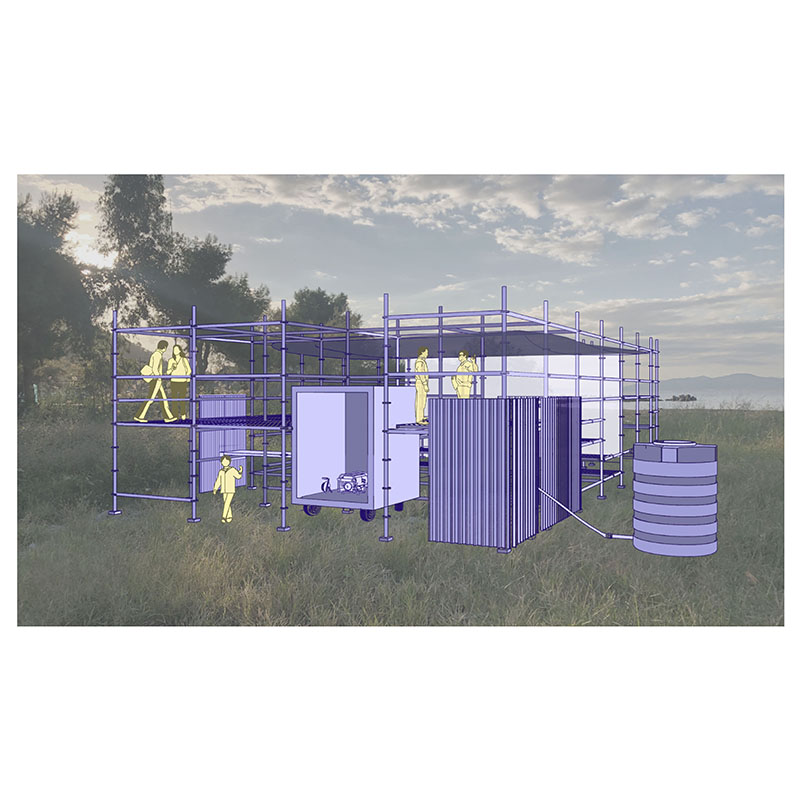

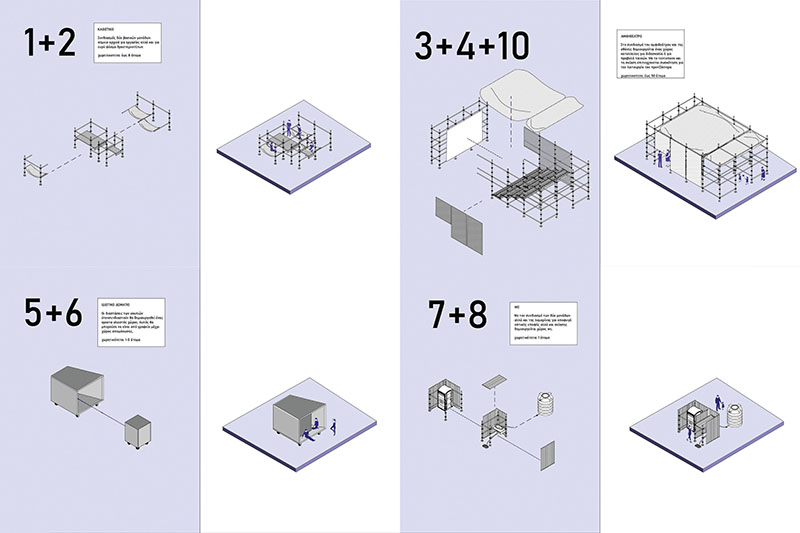

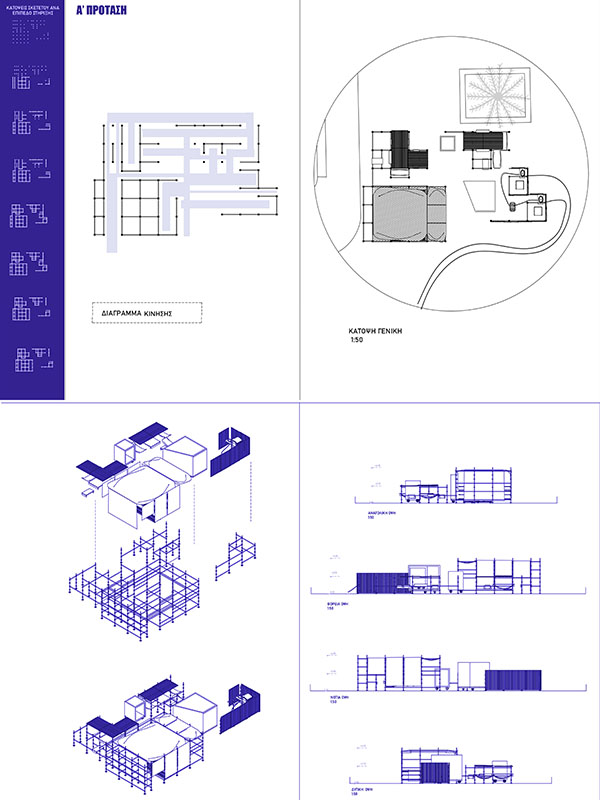

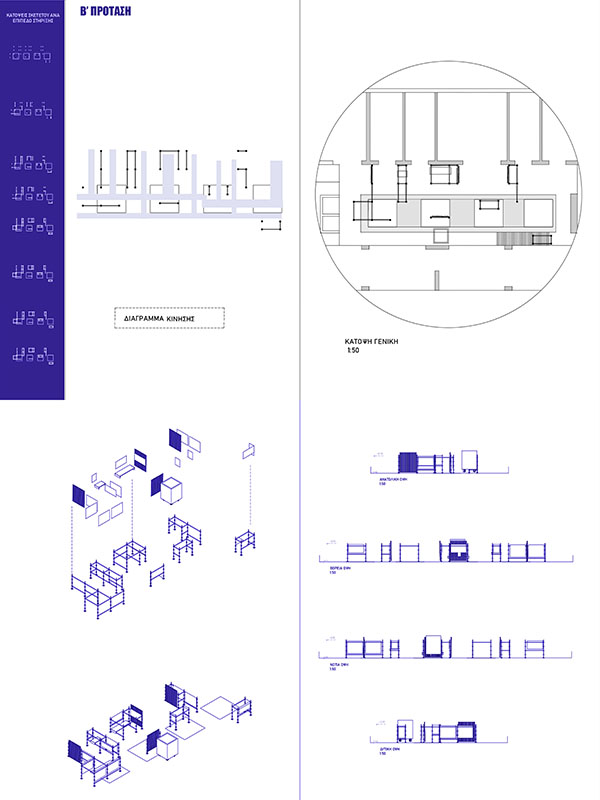

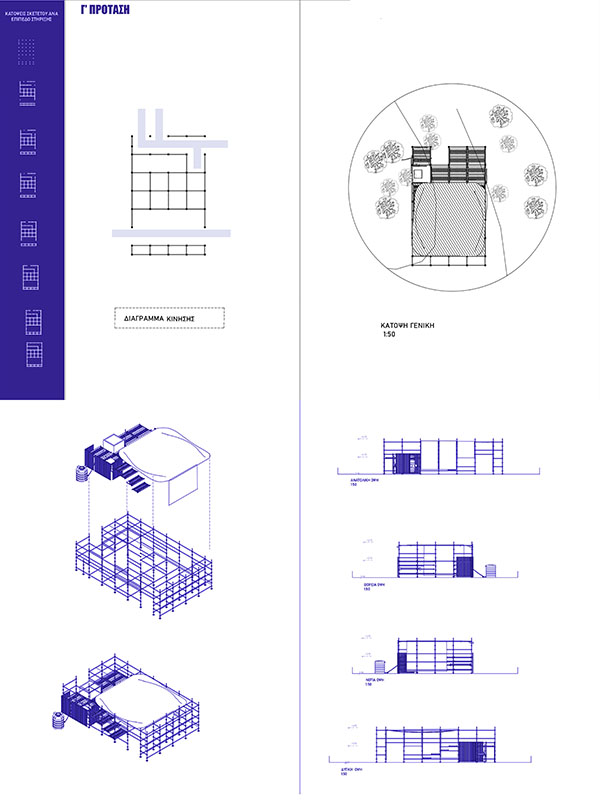

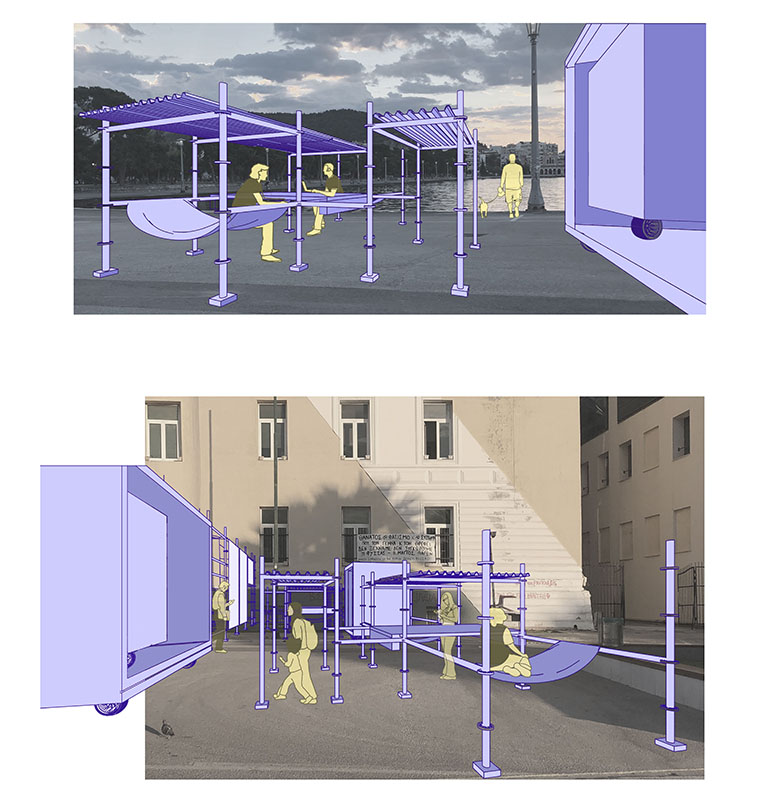

A new Department has been operating in the city of Volos for the last four years. That of Culture, New Media and Industries. Its students do not have a specific space and therefore every year they are hosted by classrooms that usually belong to other Departments. This is how the idea appeared. The design of a space that would represent this group of students, all the hours that they will need it for teaching but at the same time, to be an intervention within the system of a city that will change the possibilities of the space.
The design style was inspired by everyday images in a city and thus formed a pattern of images based on the ephemeral installations. They are necessary but the convenience they can have if they are to be assembled or transported even by the students themselves cannot be overlooked.
Thus, from the materials approach to the process of designing a scaffolding system frame, the design of units followed. Then, combination of these units and finally the installation in specific parts of the city of Volos each time.
This move strengthens the role and identity of the Department and is an important point for the communication of its members and citizens as they become part of a flexible shell that changes every time and has its own identity wherever it is located.
Supervisor: Mitroulias Giorgos
Reference Number: 960
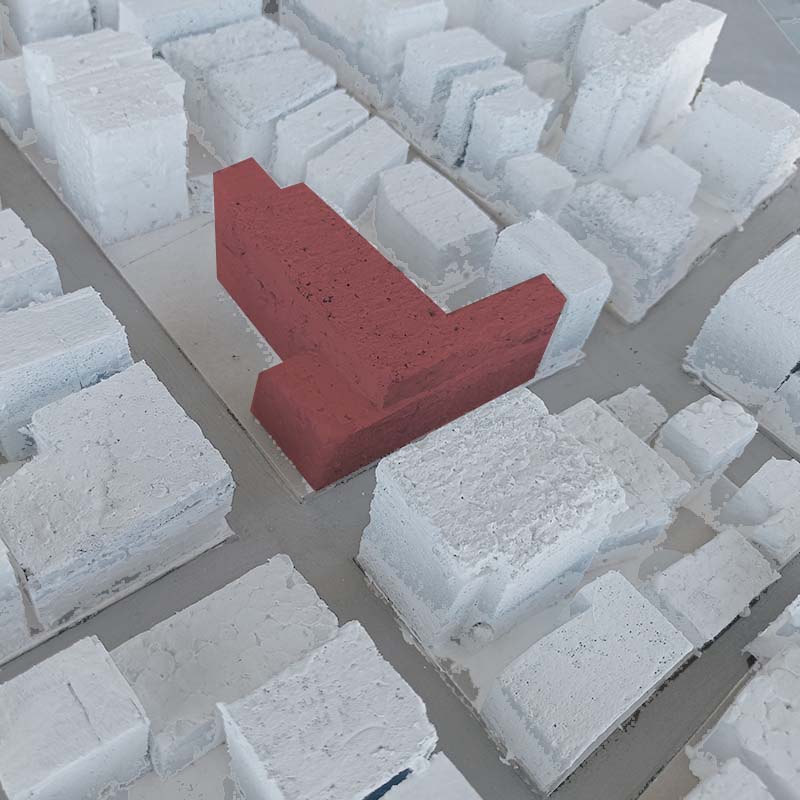

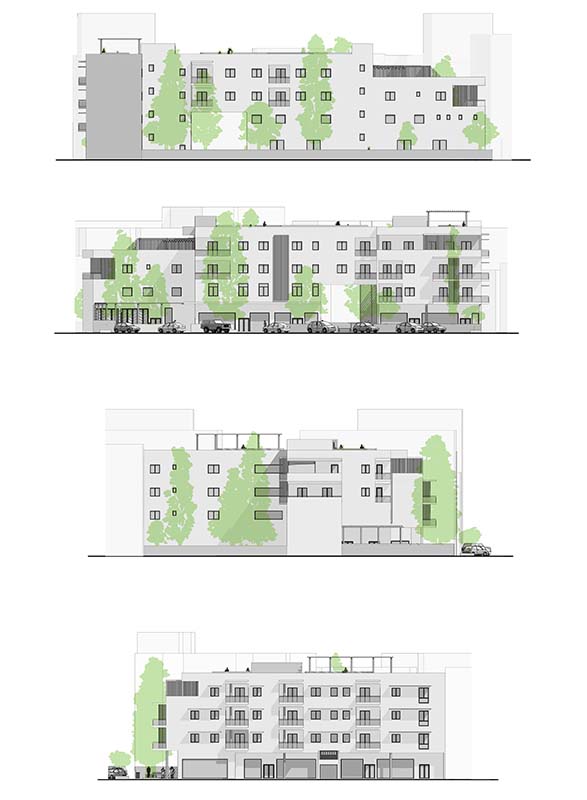

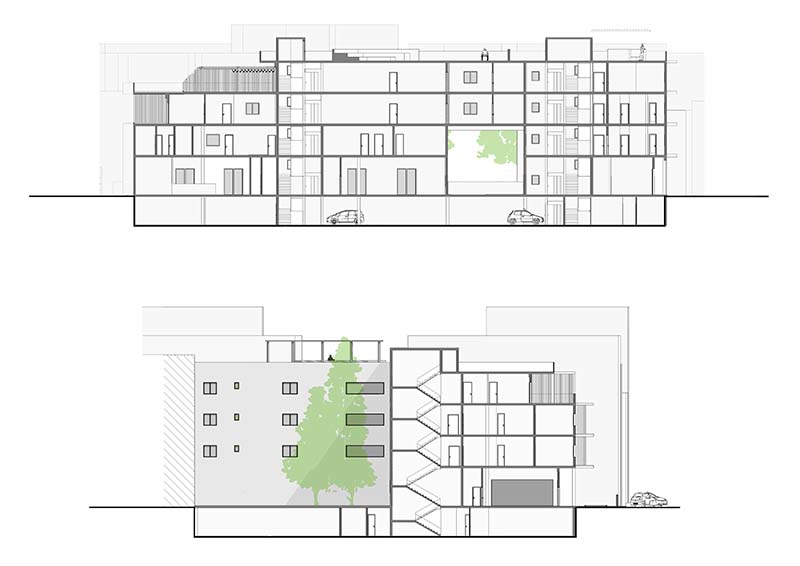

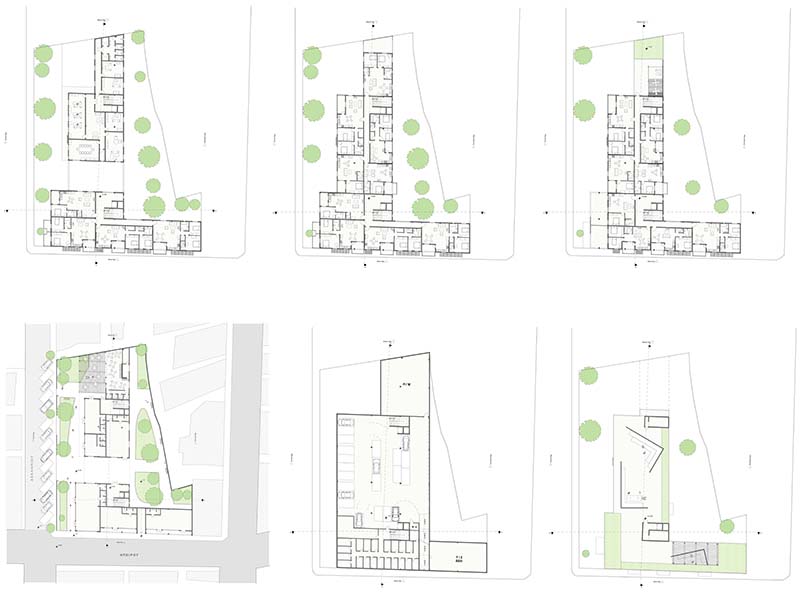

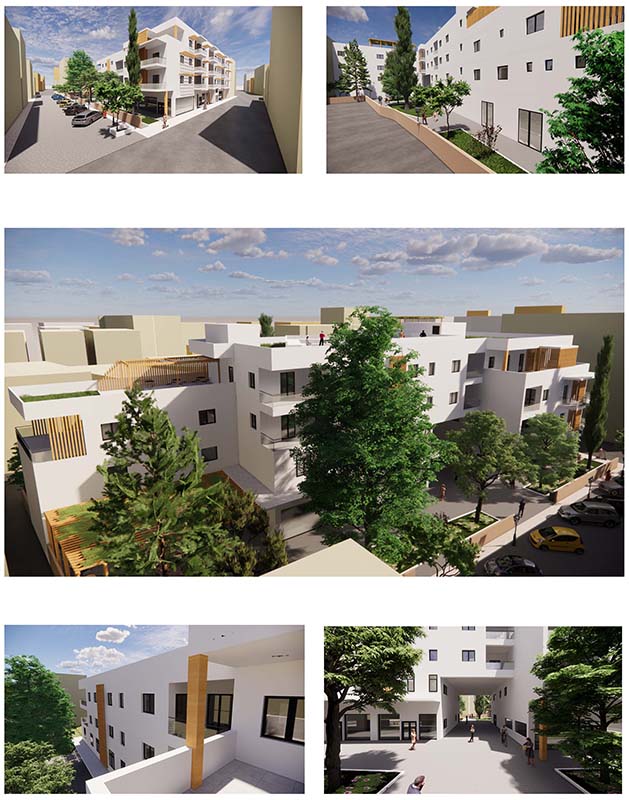

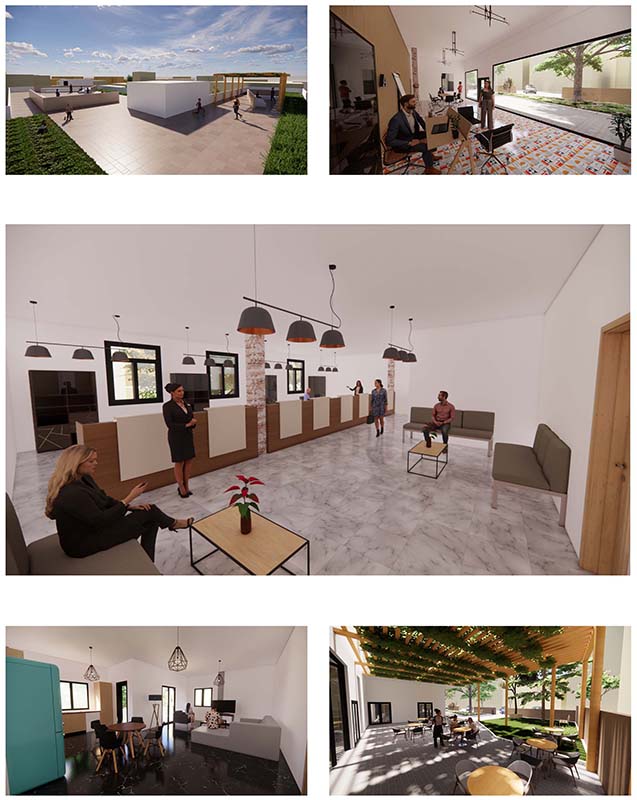

This thesis refers to the design approach of a new mixed-use building on a plot of land unused for many years in the center of the city of Larissa. The building being analyzed is located on a plot of land with a total area of 2069 sq.m, in O.T. 811A on Asklepiou & Epirou streets. It is a five-level building, which includes shops, office spaces, residences and a basement with parking and warehouses. The general shape of the plot and the requirements for the realization of a complex architectural program with a variety of uses, were basic elements on which the solution of the building was based. Given the need to separate the different functions housed in the building, we were led to a building that develops its functions in height and two staircases that ensure independent entrance to the office and residential areas. The study focuses on the spatial conditions created by the mixed-use buildings, as well as on the modern living needs of the urban space.
Supervisor: Paniyiris Costis
Reference Number: 967
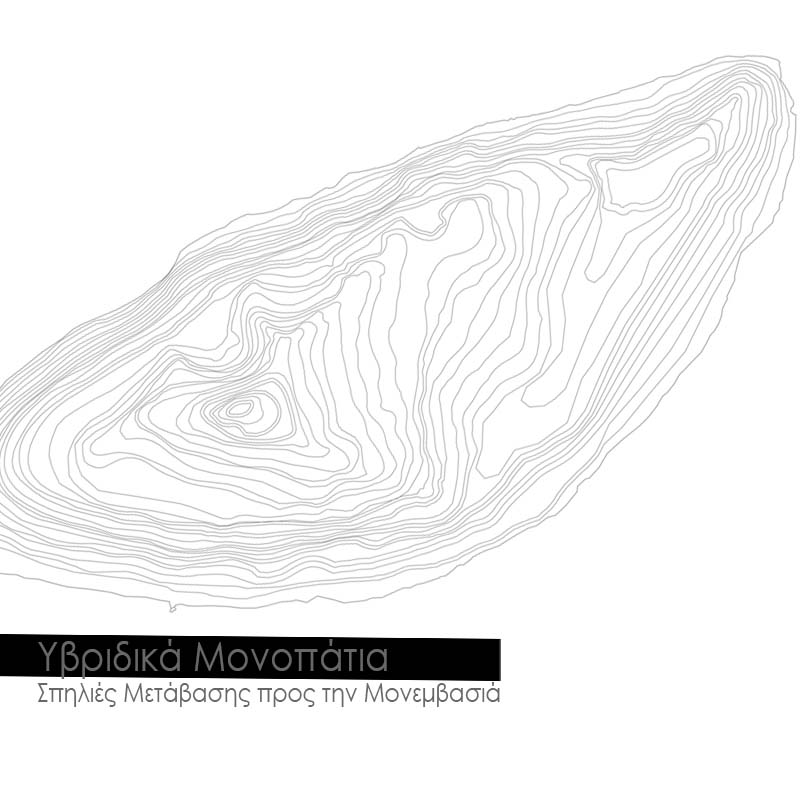

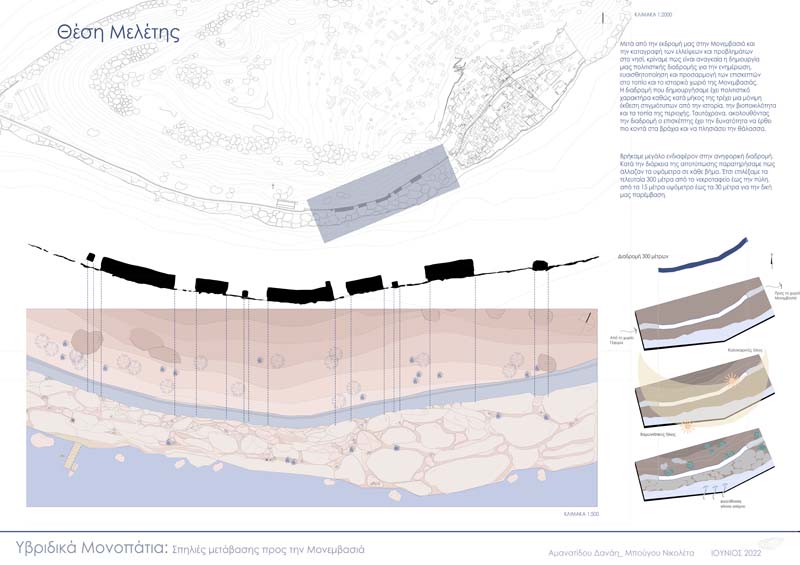

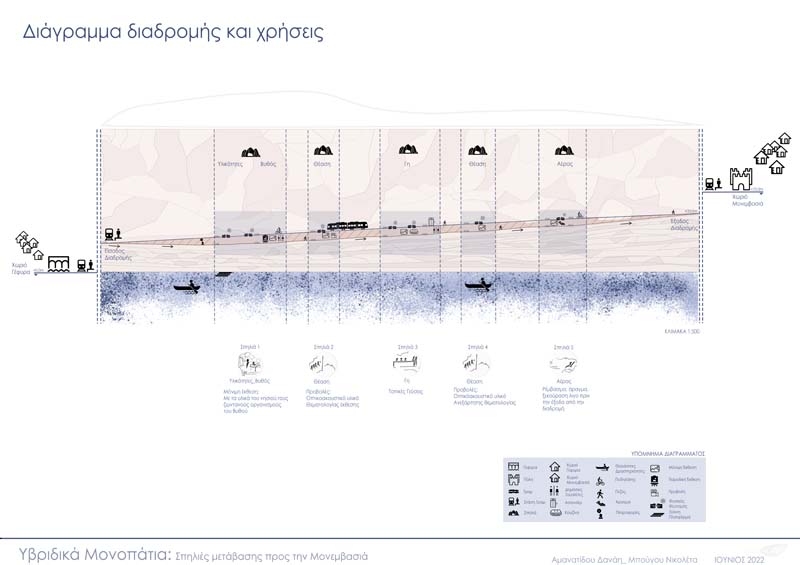

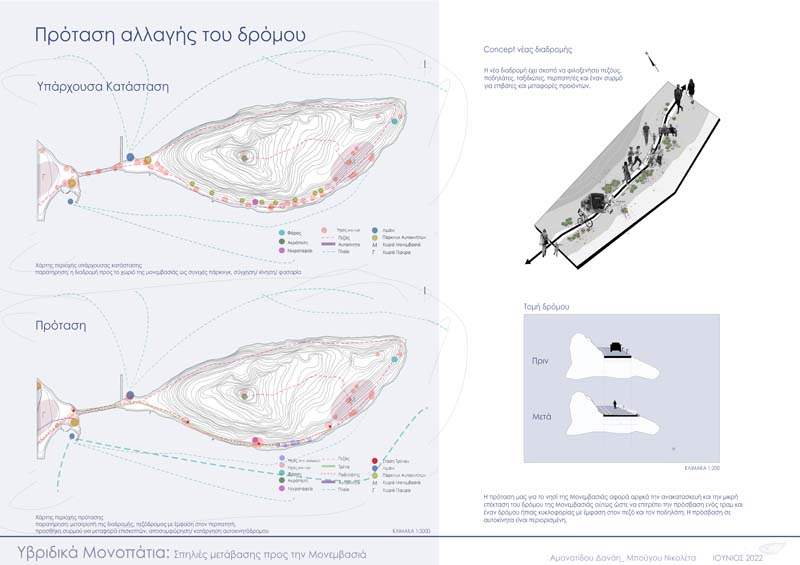

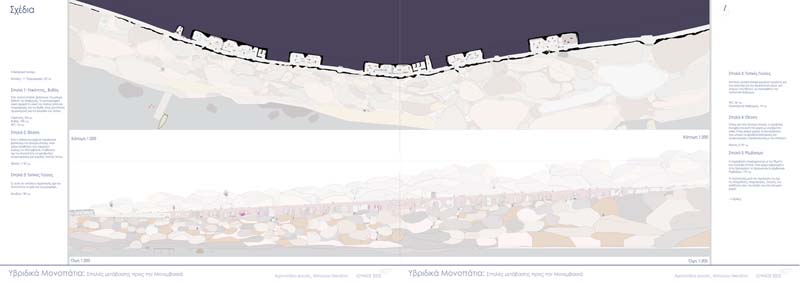

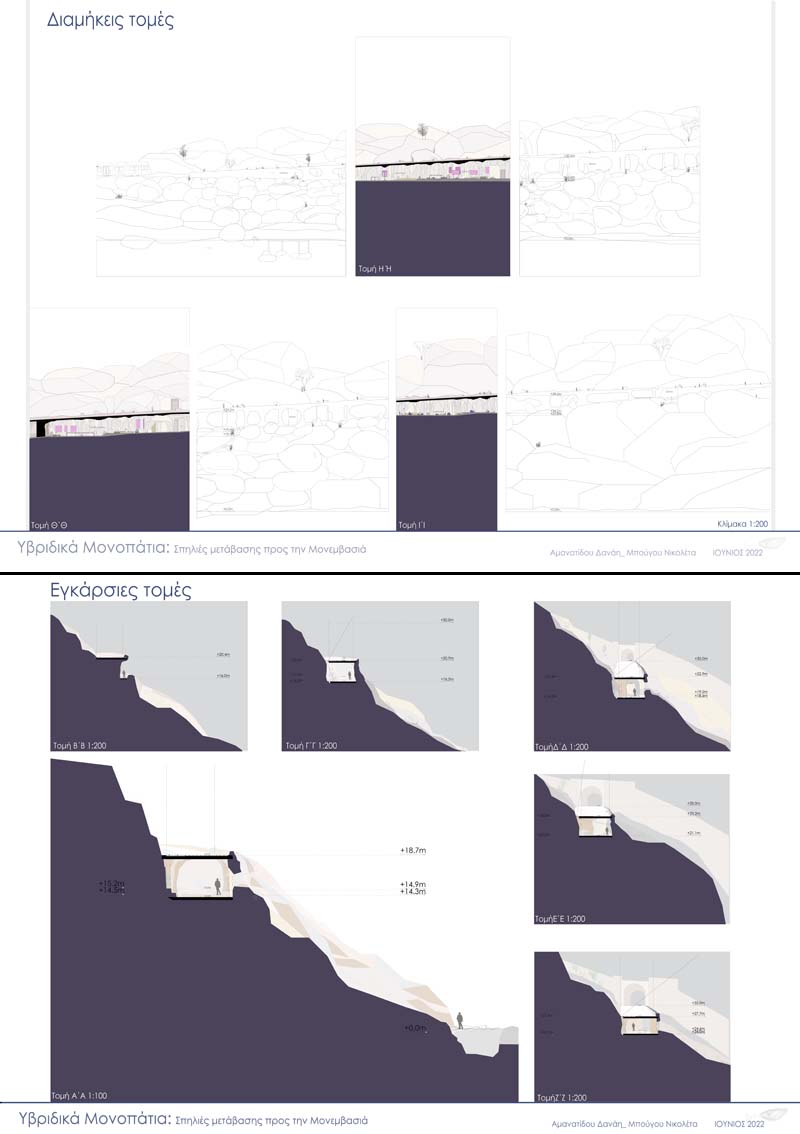

The present dissertation entitled “Hybrid Paths: Caves of transition to Monemvasia” examines the transition from the urban landscape to the medieval village of Monemvasia. The aim is to analyze the situation, identify the issues and to suggest a solution in order to change the island’s road and then to develop a parallel route. This project focuses on developing and revitalize the existing connecting road as a living organic element on the island of Monemvasia. In the first section we covered the search for archive material, bibliographic research, and field study. Once we had gathered enough data, we focused our attention to the road that connects the towns of Gefyra and Monemvasia. The current unfriendly condition for bikes and pedestrians pushed us to reconstruct the road. The new path remained simple: we stopped the car traffic, built a pedestrian road and added a tram to move people and goods.
In the second part of our proposal we added a path beneath the main road. Specifically, we created a cultural path with 5 caves that serve a variety of purposes based on travellers demands. The path is situated in the final 300 meters of the road, close to the gate of the medieval village. A ramp provides entry to the caves, allowing visitors to explore the spaces and cross the rocks through narrow routes placed close to the sea.
We wanted the purposes of our intervention to be specifically tied to the island, since the purpose of our path is to get the visitor ready for his subsequent visit to the castle, we wanted the purposes of our intervention to be specifically tied to the island. The caves especially feature a permanent exhibition about the island and its history, two movie rooms, an open-concept kitchen, a rest space, public restrooms, a disabled toilet, and an elevator.
The entire plan was created with the intention of preserving the landscape, eradicating urban lines, and improving the access road to the island.
Supervisor: Stylidis Iordanis
Reference Number: 939
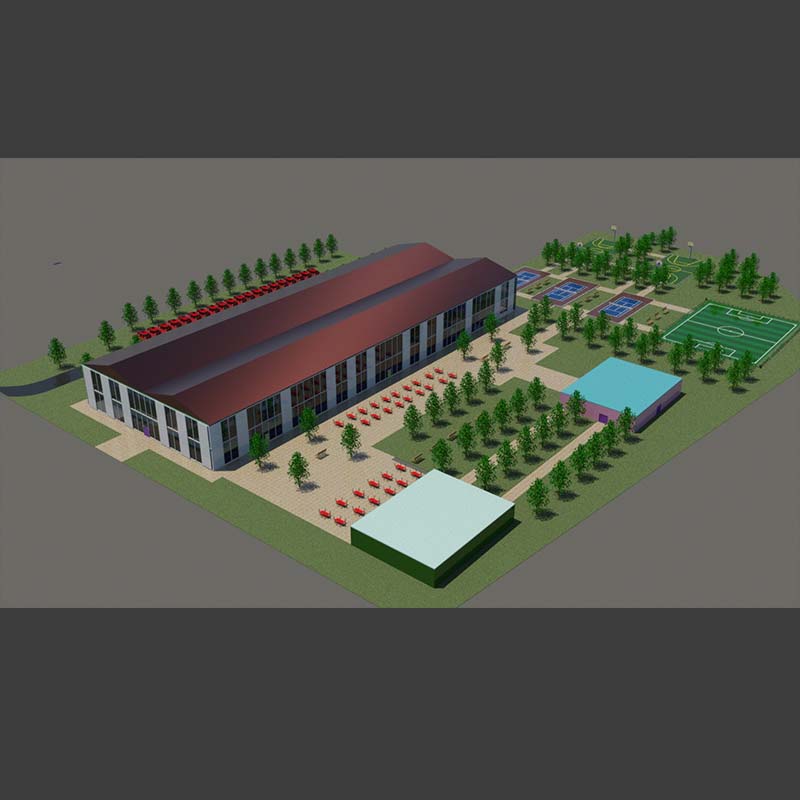

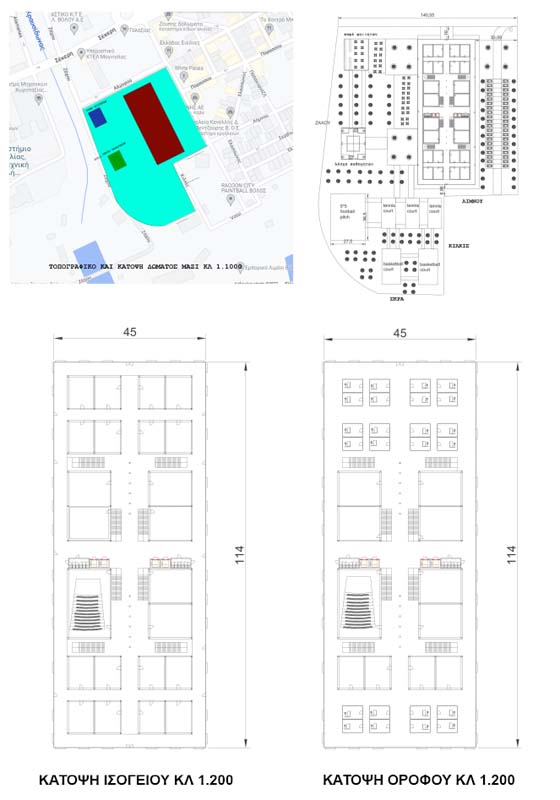

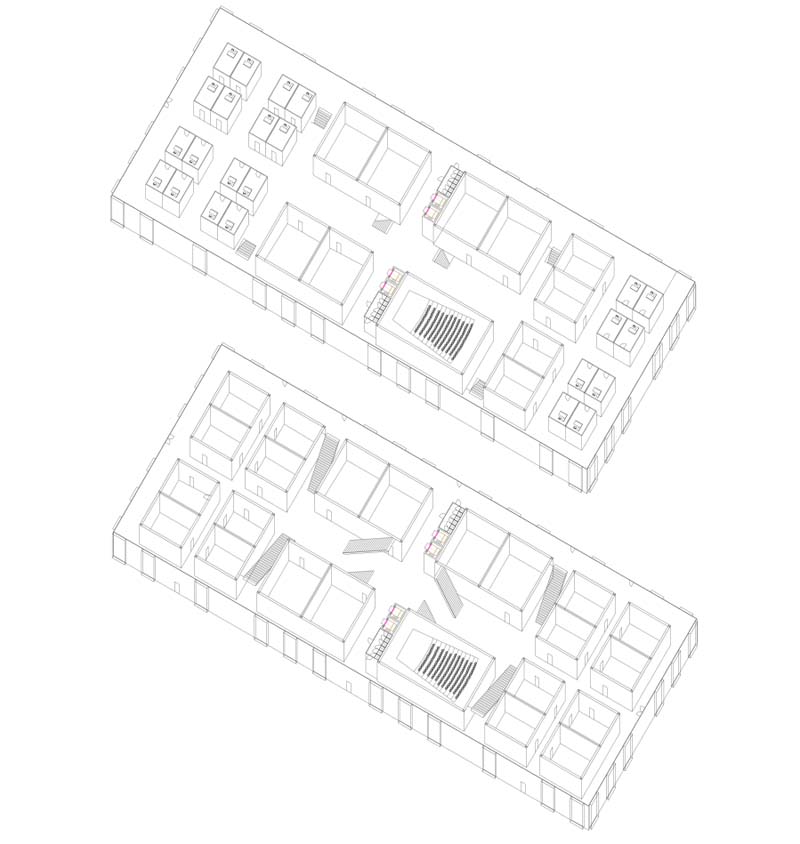

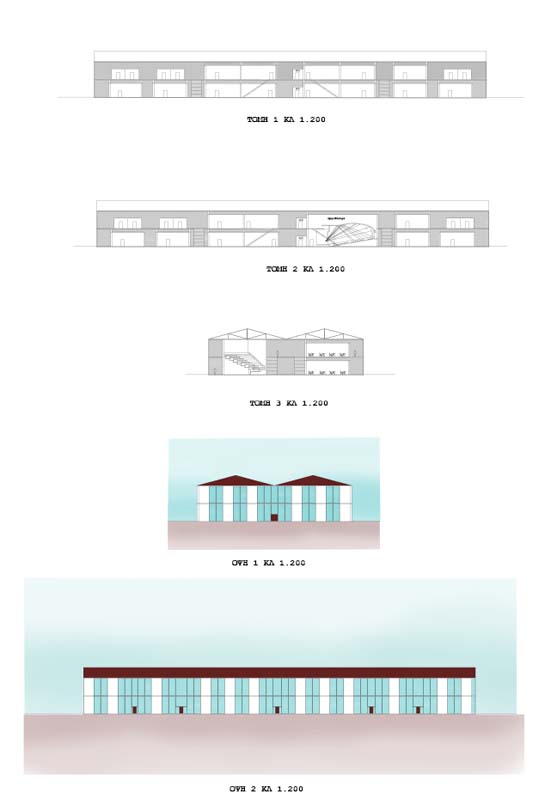

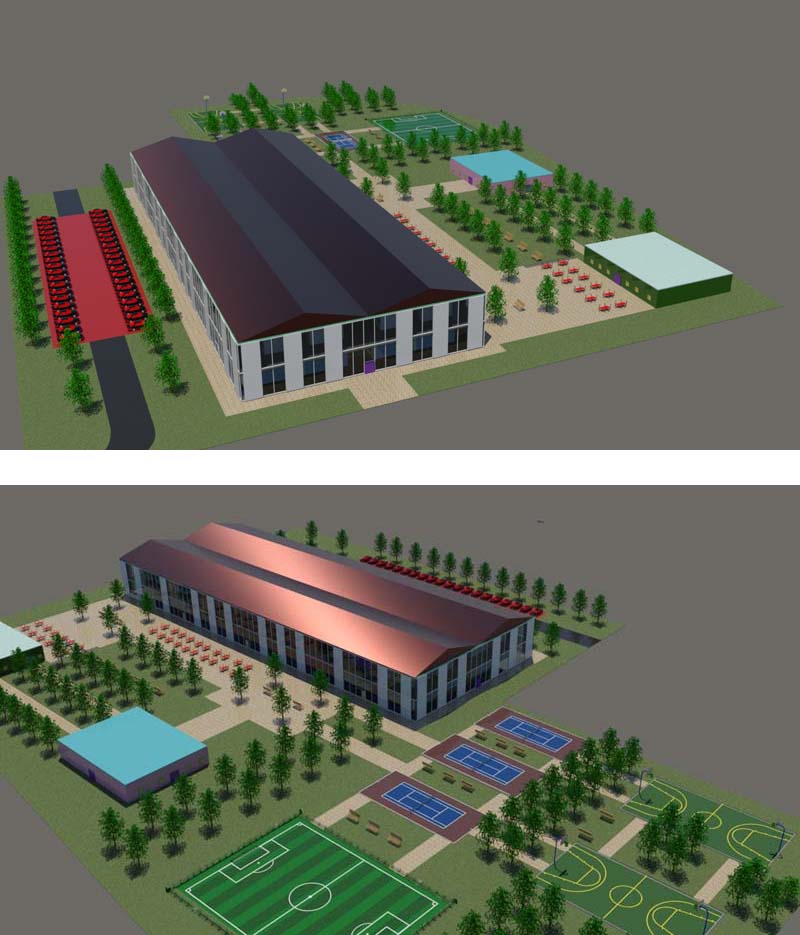

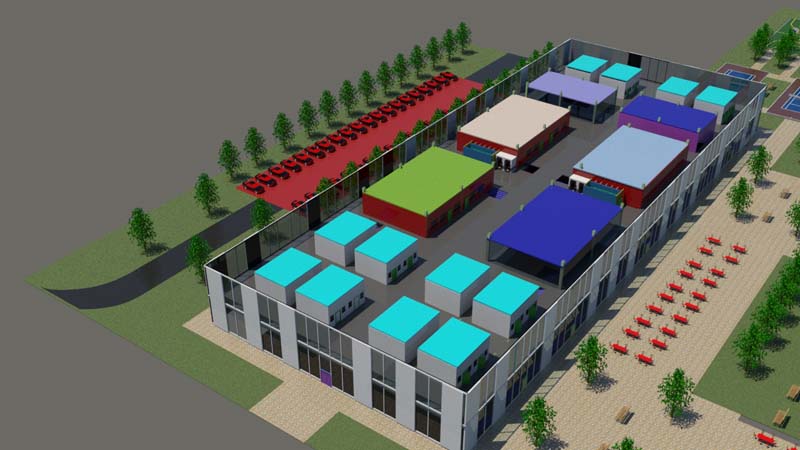

My dissertation concerns the creation of a university unit, a philosophical school, a university of philosophy that will be placed next to the polytechnic school on the plot behind the city’s bus station. It is a school that will cover a wide range of subjects and will bring students in contact with all aspects of the humanities by cultivating a multifaceted and thorough contact with the science of philosophy and related sciences. The present work, being a personal product of research, is a school of philosophy as I personally imagine it, as I would like it to be, as I dreamed and envisioned it; a school that is not limited to philosophy, but extends, also, to cover the relevant field of literature. The school will include classrooms, an amphitheater, and teachers' offices.
The school, as far as its curriculum is concerned, will include the following two fields: Field of philology, and field of philosophy.
The main scientific goal of the field of philology is to bring students in contact with all aspects and manifestations of literature, from the study of ancient Greek and Latin literature to the exploration of medieval and modern European and Greek literature, as well as to introduce them to the systematic analysis of language, ultimately aiming at their fullest spiritual integration.
The mission of the field of philosophy is the study and research of philosophy, both in its systematic and in its historical dimension, with emphasis on ontology and metaphysics, epistemology and philosophy of science, practical philosophy and ethics, social and political philosophy, aesthetics and the philosophy of art, ancient Greek and modern Greek philosophy, as well as modern and contemporary philosophy.
Supervisor: Kanarelis Theoklis
Reference Number: 959
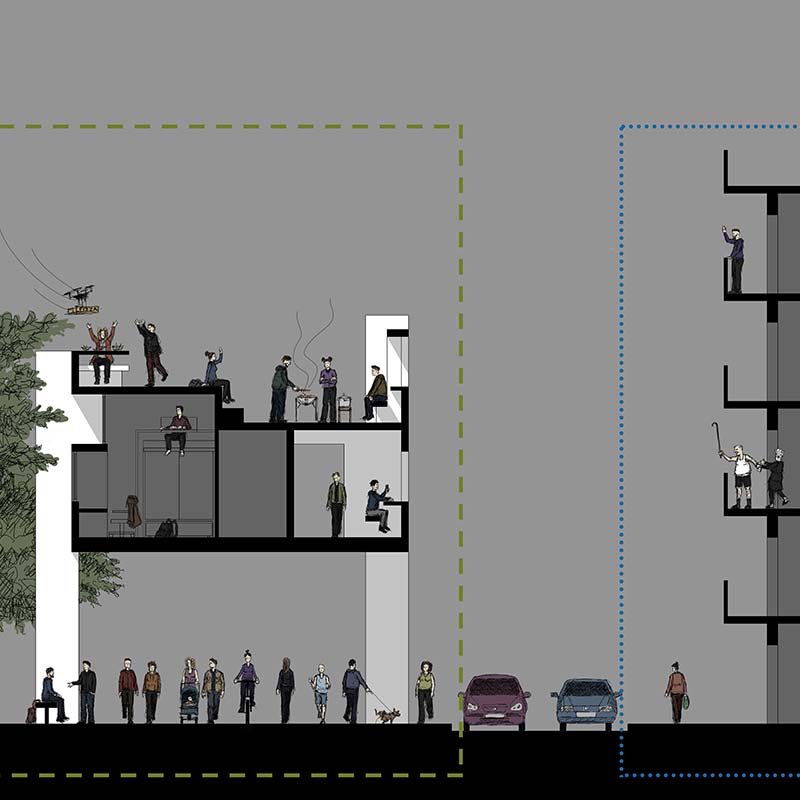

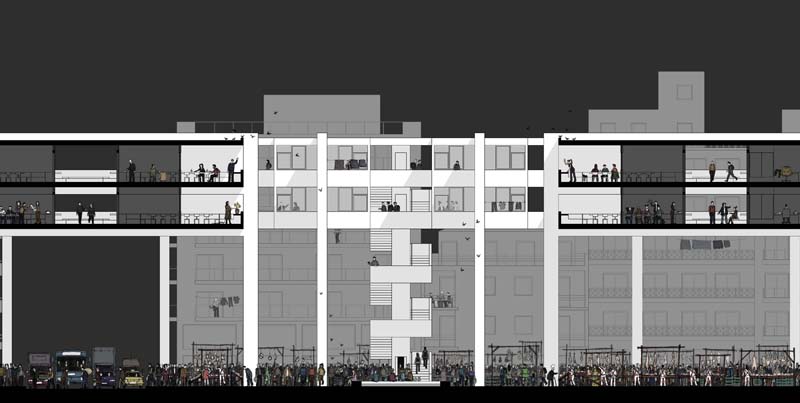

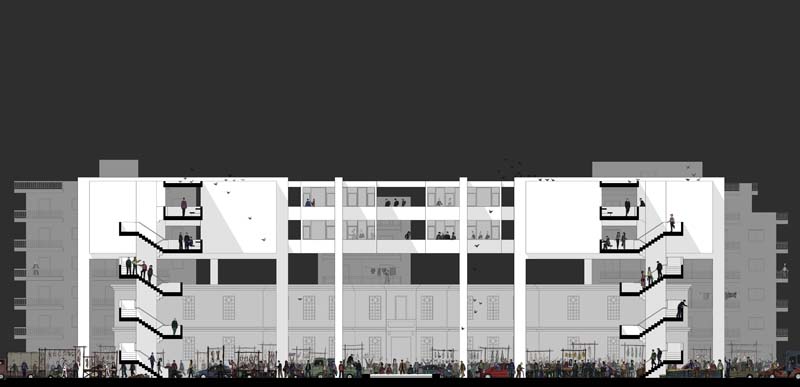

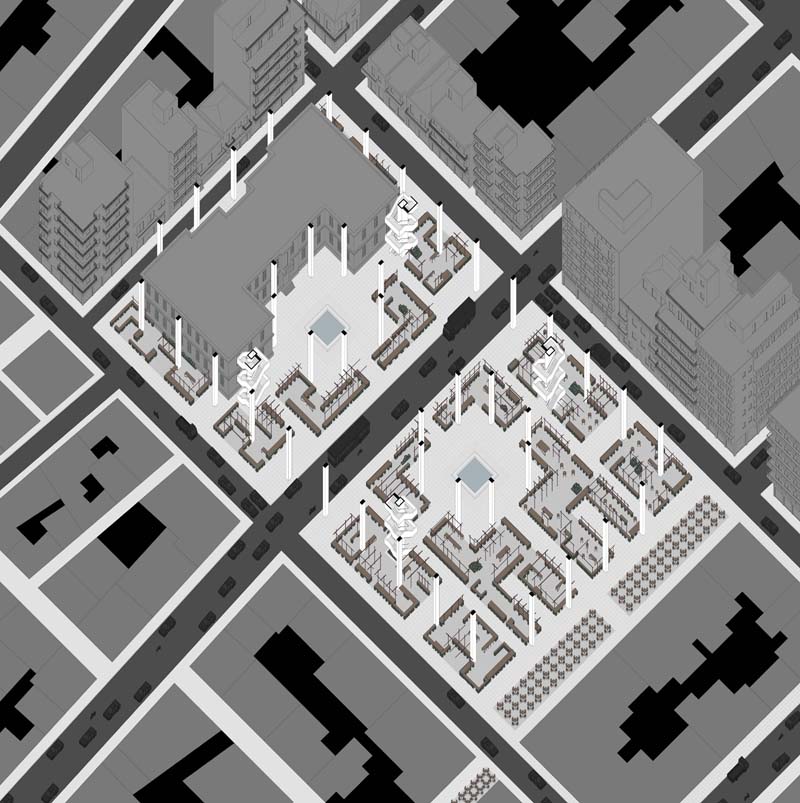

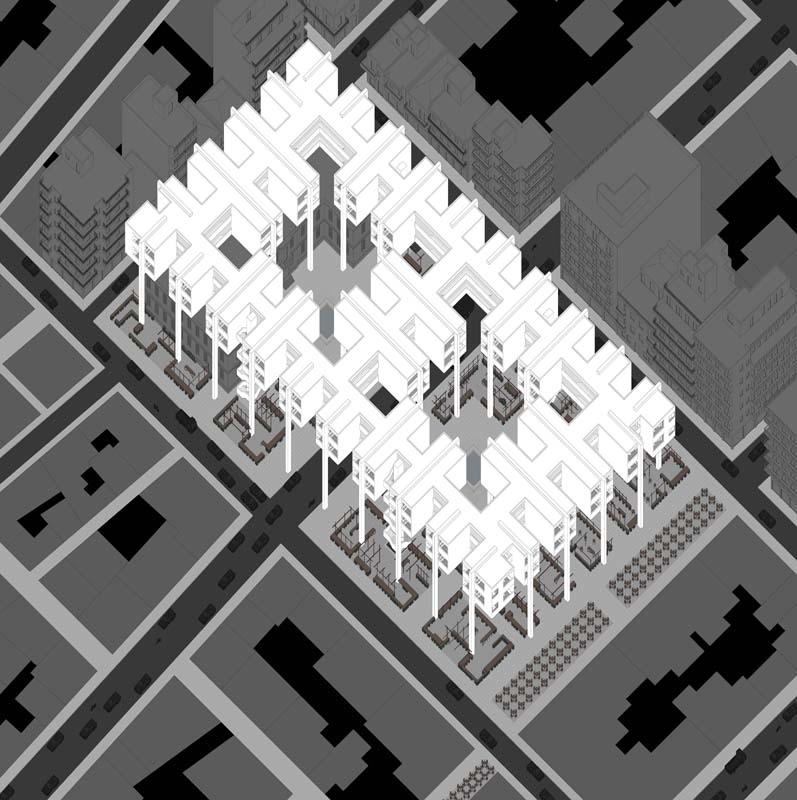

How could groups of standard and mass-produced houses be designed, so that, students could be united in groups and at the same time, be fully integrated into city life? Perhaps if the houses were growing, like parasites, in the common - public spaces of Volos, such a situation could arise. In this diploma, an effort is made to design constructions that turn the student residences into an integral part of the public spaces that already exist in the city. Attempts are therefore being made to "graft" the common ground of the city with the aim of both improving its characteristics and producing quality housing for students. In the first phase, a series of experiments are performed using a sketch, where the parasites colonize various possible sites. This is where all three typologies, that were finally resolved, emerge. The surface, the line and the point - tower. Then there is a more detailed analysis of the characteristics of some of the public spaces that seem to be interesting the most, as well as the creation of a map of the city where the common ground of the city is divided into white (active and accessible by all) and black (inactive, abandoned, closed). In the final stage, the analysis of the characteristics of each of the three public spaces that are selected, now lead to dimensioned proposals. The axonometric drawings and sections illustrate a situation in which brutalist buildings step on the common ground of the city, just in order to multiply it upwards. So, student residences are depicted as an integral part of constructions, that are aimed to be a unified body with the public place they colonize.
Supervisor: Paniyiris Costis
Reference Number: 933

